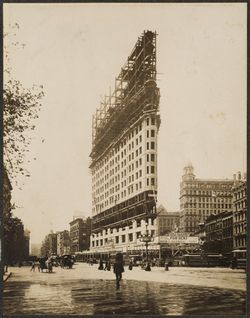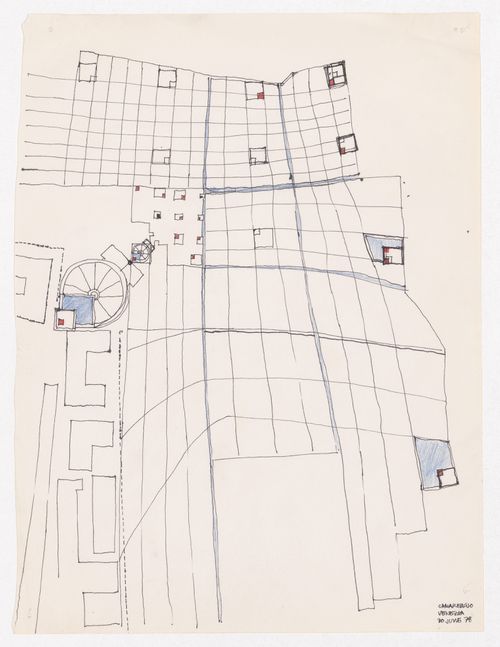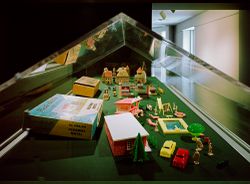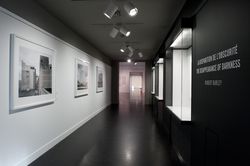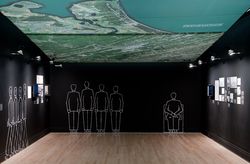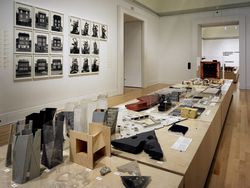documents textuels
DR2021:0052:001-039
Description:
The papers in this collection are related to the participation of Barry Campbell in a project to create a 1:50 scale model for the Maison d'Artiste, an unbuilt project designed by architects Theo van Doesburg and Cor van Eesteren in 1923. The model, sponsored by lawyer Piet Sanders and Barry Campbell, was made by Frans Postma and was exhibited at the Stedelijk Museum De Lakenhal (2009-2010) and the Tate Modern (2010) as part of the exhibition "Van Doesburg and the International Avant Garde: Constructing a New World". In 2013, Barry Campbell, Frans Postma and Victor Veldhuijzen van Zanten donated the 1:50 model to Het Nieuwe Instituut/The New Institute in Rotterdam, the Netherlands (Piet Sanders, who died in September, 2012, was also named as a donor). A 1:75 scale model was made for each of the donors. Textual records in the collection include correspondence, a copy of the donor agreement, and a text by Bertus Mulder. Drawings include printouts of plans, elevations, sections, and perspectives. There are also photographs of drawings. Digital files consist of a panorama by Postma & Partner. The collection includes a printout of a photograph of Barry Campbell with the 1:50 model.
2007-2013
Barry Campbell papers related to a 1:50 scale model for the Maison d'Artiste
Actions:
DR2021:0052:001-039
Description:
The papers in this collection are related to the participation of Barry Campbell in a project to create a 1:50 scale model for the Maison d'Artiste, an unbuilt project designed by architects Theo van Doesburg and Cor van Eesteren in 1923. The model, sponsored by lawyer Piet Sanders and Barry Campbell, was made by Frans Postma and was exhibited at the Stedelijk Museum De Lakenhal (2009-2010) and the Tate Modern (2010) as part of the exhibition "Van Doesburg and the International Avant Garde: Constructing a New World". In 2013, Barry Campbell, Frans Postma and Victor Veldhuijzen van Zanten donated the 1:50 model to Het Nieuwe Instituut/The New Institute in Rotterdam, the Netherlands (Piet Sanders, who died in September, 2012, was also named as a donor). A 1:75 scale model was made for each of the donors. Textual records in the collection include correspondence, a copy of the donor agreement, and a text by Bertus Mulder. Drawings include printouts of plans, elevations, sections, and perspectives. There are also photographs of drawings. Digital files consist of a panorama by Postma & Partner. The collection includes a printout of a photograph of Barry Campbell with the 1:50 model.
documents textuels
2007-2013
Scaled map of the coast of France, with locations of major cities in France and western Europe
DR1974:0002:001:002
topographique
1822
Scaled map of the coast of France, with locations of major cities in France and western Europe
Actions:
DR1974:0002:001:002
topographique
L’exposition Architectes de l’image : les photographes à l’âge héroïque des grands travaux fait ressortir les liens entre la représentation photographique et les grands travaux entrepris au cours du premier siècle de développement de la photographie dans les domaines de l’architecture et de l’ingénierie. L’idée centrale de l’exposition – le photographe vu comme un(...)
11 octobre 1995 au 4 février 1996
Architectes de l'image : les photographes à l'âge héroïque des grands travaux
Actions:
Description:
L’exposition Architectes de l’image : les photographes à l’âge héroïque des grands travaux fait ressortir les liens entre la représentation photographique et les grands travaux entrepris au cours du premier siècle de développement de la photographie dans les domaines de l’architecture et de l’ingénierie. L’idée centrale de l’exposition – le photographe vu comme un(...)
DR1991:0017:001
Description:
site plan
1978
Sketch site plan with plan of S. Simeone Piccolo church at two different scales and deformed grid of houses for International Seminary of Design in the Area of Cannaregio-West, Venice, Italy
Actions:
DR1991:0017:001
Description:
site plan
Les jouets sont de précieux témoignages sur la vie sociale et économique d’une époque. De plus, des blocs de construction en bois aux jeux de construction en fer et en acier, ils reflètent des changements techniques et des styles d’architecture très en vogue à un certain moment. Par ailleurs, les principes des techniques nouvelles à l’origine des nouveaux bâtiments, ont(...)
Salle octogonale
28 novembre 1990 au 31 mars 1991
L'architecture en jeux : jeux de construction du CCA
Actions:
Description:
Les jouets sont de précieux témoignages sur la vie sociale et économique d’une époque. De plus, des blocs de construction en bois aux jeux de construction en fer et en acier, ils reflètent des changements techniques et des styles d’architecture très en vogue à un certain moment. Par ailleurs, les principes des techniques nouvelles à l’origine des nouveaux bâtiments, ont(...)
Salle octogonale
L’exposition Robert Burley : La disparition de l’obscurité présente une série de photographies de l’artiste canadien Robert Burley documentant la disparition des industries de produits photographiques traditionnels en réponse à l’impact des nouvelles technologies. Depuis 2005, la mutation de la technologie photographique, qui est passée de l’analogique au numérique, (...)
Vitrines
11 septembre 2009 au 15 novembre 2009
Robert Burley : La disparition de l'obscurité
Actions:
Description:
L’exposition Robert Burley : La disparition de l’obscurité présente une série de photographies de l’artiste canadien Robert Burley documentant la disparition des industries de produits photographiques traditionnels en réponse à l’impact des nouvelles technologies. Depuis 2005, la mutation de la technologie photographique, qui est passée de l’analogique au numérique, (...)
Vitrines
Les armées de la Seconde Guerre mondiale ne représentent guère que la pointe d’icebergs entrant en collision, ces nations belligérantes qui se sont mobilisées et transformées pour une guerre de production d’une ampleur jusqu’alors inconnue. Architecture en uniforme : Projeter et construire pour la Seconde Guerre mondiale porte sur la vaste contribution de l’architecture à(...)
Salles principales
13 avril 2011 au 18 septembre 2011
Architecture en uniforme : Projeter et construire pour la Seconde Guerre mondiale
Actions:
Description:
Les armées de la Seconde Guerre mondiale ne représentent guère que la pointe d’icebergs entrant en collision, ces nations belligérantes qui se sont mobilisées et transformées pour une guerre de production d’une ampleur jusqu’alors inconnue. Architecture en uniforme : Projeter et construire pour la Seconde Guerre mondiale porte sur la vaste contribution de l’architecture à(...)
Salles principales
PH1979:0508
Description:
This album depicts photographs, plans, sketches of Stonehenge and texts. Preface is signed by Sir Henry James, 29th May 1867, Southhampton. Album has appendix and List of Books inserted at the end. "Col. Sir Henry James, Director-General of the Ordnance Survey, was a strong believer that photography had to be utilized as a major tool for mapping and survey work and he employed the Royal Engineers for that purpose. Colonel James appears in several of the Stonehenge photographs published by the Ordnance Survey. [...] Stonehenge is the world's most famous, large megalithic stone circle and is usually designated as a site used for religious worship in Neolithic Britain. However, the first use of this locality for documented ritual activity goes back to the Mesolithic and the erection of several large totem poles perhaps as early as 8,000 BC (Stonehenge O). Lunar observations preceded the construction of a causeway c.3200 BC, followed by an earth circle and Heel Stones c.3100 BC (Stonehenge 1a) and the Aubrey Holes (Stonehenge 1b). The Stonehenge site was then abandoned for about 1,000 years when large bluestones quarried in Wales were brought to the site and made into the Double Bluestone Circle with Avenue. 2150 BC (Stonehenge II). Soon thereafter sarsen stones were brought in from Avebury to build the great Sarsen Circle and Trilithon Horseshoe, 2100 BC (Stonehenge IIIz). Bluestones were brought back and added as the Bluestone Circle and Bluestone Horseshoe to the sarsen monument, 1800 BC (Stonehenge IIId). The sacred avenue was extended to the River Avon, 1100 BC (Stonehenge IV), the last phase of megalithic construction at this site. Note that the great stone circle and all construction at the Stonehenge site was completed several hundred years before we can postulate Celtic druids in the vicinity. We can only mention in passing that Stonehenge was embedded within a large ritual complex, where several of the ten megalithic constructions were also monumental in scale. Integration between these structures may not have been well planned in advance, but assuredly was articulated as each was built." Neolithic Britian Online.
sculpture, topographique
1867
Plans and Photographs of Stonehenge, and of Turusachan in the Island of Lewis; with Notes Relating to the Druids and Sketches of Cromlechs in Ireland
Actions:
PH1979:0508
Description:
This album depicts photographs, plans, sketches of Stonehenge and texts. Preface is signed by Sir Henry James, 29th May 1867, Southhampton. Album has appendix and List of Books inserted at the end. "Col. Sir Henry James, Director-General of the Ordnance Survey, was a strong believer that photography had to be utilized as a major tool for mapping and survey work and he employed the Royal Engineers for that purpose. Colonel James appears in several of the Stonehenge photographs published by the Ordnance Survey. [...] Stonehenge is the world's most famous, large megalithic stone circle and is usually designated as a site used for religious worship in Neolithic Britain. However, the first use of this locality for documented ritual activity goes back to the Mesolithic and the erection of several large totem poles perhaps as early as 8,000 BC (Stonehenge O). Lunar observations preceded the construction of a causeway c.3200 BC, followed by an earth circle and Heel Stones c.3100 BC (Stonehenge 1a) and the Aubrey Holes (Stonehenge 1b). The Stonehenge site was then abandoned for about 1,000 years when large bluestones quarried in Wales were brought to the site and made into the Double Bluestone Circle with Avenue. 2150 BC (Stonehenge II). Soon thereafter sarsen stones were brought in from Avebury to build the great Sarsen Circle and Trilithon Horseshoe, 2100 BC (Stonehenge IIIz). Bluestones were brought back and added as the Bluestone Circle and Bluestone Horseshoe to the sarsen monument, 1800 BC (Stonehenge IIId). The sacred avenue was extended to the River Avon, 1100 BC (Stonehenge IV), the last phase of megalithic construction at this site. Note that the great stone circle and all construction at the Stonehenge site was completed several hundred years before we can postulate Celtic druids in the vicinity. We can only mention in passing that Stonehenge was embedded within a large ritual complex, where several of the ten megalithic constructions were also monumental in scale. Integration between these structures may not have been well planned in advance, but assuredly was articulated as each was built." Neolithic Britian Online.
1867
sculpture, topographique
Lancé en novembre 1998 par la Fondation du Centre Canadien d’Architecture, le Prix du CCA pour la conception des villes invitait les architectes du monde entier à relever un défi qui se pose à toutes les grandes villes à l’aube du XXIe siècle : la revitalisation de secteurs urbains lacérés par d’importantes structures liées aux transports, vestiges de l’activité(...)
Salles principales
15 novembre 2000 au 1 avril 2001
New York : Concours CCA pour la conception des villes
Actions:
Description:
Lancé en novembre 1998 par la Fondation du Centre Canadien d’Architecture, le Prix du CCA pour la conception des villes invitait les architectes du monde entier à relever un défi qui se pose à toutes les grandes villes à l’aube du XXIe siècle : la revitalisation de secteurs urbains lacérés par d’importantes structures liées aux transports, vestiges de l’activité(...)
Salles principales
Herzog de Meuron: archéologie de l’imaginaire présente un éventail exhaustif de documents provenant des archives des architectes Herzog de Meuron et de collections connexes. À l’image d’une exposition d’histoire naturelle, celle-ci comprend maquettes d’étude, livres, photographies, jouets, photographies, fossiles, pierres de lettrés chinois ainsi que quelques œuvres(...)
Salles principales
23 octobre 2002 au 6 avril 2003
Herzog & de Meuron : archéologie de l'imaginaire
Actions:
Description:
Herzog de Meuron: archéologie de l’imaginaire présente un éventail exhaustif de documents provenant des archives des architectes Herzog de Meuron et de collections connexes. À l’image d’une exposition d’histoire naturelle, celle-ci comprend maquettes d’étude, livres, photographies, jouets, photographies, fossiles, pierres de lettrés chinois ainsi que quelques œuvres(...)
Salles principales

